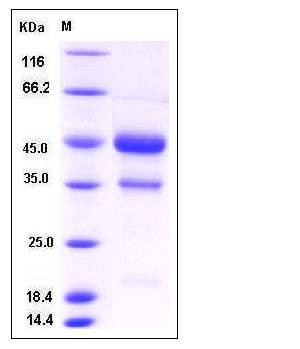Mouse VEGF-D / VEGFD / FIGF Protein (Fc Tag)
AI325264,VEGF-D,Vegfd
- 100ug (NPP1604) Please inquiry
| Catalog Number | P50157-M01H |
|---|---|
| Organism Species | Mouse |
| Host | Human Cells |
| Synonyms | AI325264,VEGF-D,Vegfd |
| Molecular Weight | The recombinant mouse FIGF/Fc is a disulfide-linked homodimer. The reduced monomer comprises 369 amino acids and has a calculated molecular mass of 40.6 kDa.The apparent molecular mass of the protein is approximately 45 and 36 kDa in SDS-PAGE under reducing conditions. |
| predicted N | Glu |
| SDS-PAGE |  |
| Purity | > (65.7+30.1) % as determined by SDS-PAGE |
| Protein Construction | A DNA sequence encoding the mature form of mouse FIGF (P97946) (Phe 98-Ser 206) was fused with the Fc region of human IgG1 at the N-terminus. |
| Bio-activity | 1. Measured by its binding ability in a functional ELISA. 2. Immobilized human VEGFR3-His (P10806-H08H) at 10 μg/mL (100 μl/well) can bind mouse Fc-VEGFD, The EC50 of mouse Fc-VEGFD is 49 ng/mL. 3. Immobilized mouse VEGFR3-His (P50584-M08H) at 10 μg/mL (100 μl/well) can bind mouse Fc-VEGFD, The EC50 of mouse Fc-VEGFD is 44 ng/mL. |
| Research Area | Cardiovascular |Angiogenesis |Growth Factor & Receptor |Vascular Endothelial Growth Factor (VEGF) & Receptor |Vascular Endothelial Growth Factor (VEGF) |
| Formulation | Lyophilized from sterile PBS, pH 7.4 1. Normally 5 % - 8 % trehalose and mannitol are added as protectants before lyophilization. Specific concentrations are included in the hardcopy of COA. |
| Background | Vascular endothelial growth factor D (VEGF-D), also known as C-fos induced growth factor (FIGF), belongs to the platelet-derived growth factor/vascular endothelial growth factor (PDGF/VEGF) family. FIGF protein is active in angiogenesis, lymphangiogenesis, and endothelial cell growth. FIGF protein is secreted as a non-covelent homodimer in an antiparallel fashion. Human FIGF protein is expressed in adult lung, heart, muscle, and small intestine, and is most abundantly expressed in fetal lungs and skin. FIGF protein is structurally and functionally similar to VEGF-C. Therefore, FIGF protein binds and activates VEGFR-2 (Flk1) and VEGFR-3 (Flt4) receptors, and may particularly be involved in cancers, such as breast cancer, epithelial ovarian carcinoma and so on. |
| Reference |
